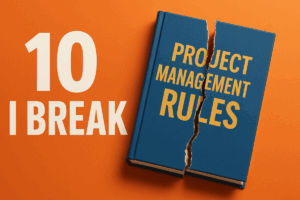Vendor Success with QBRs: Achieve Customer Success with Quarterly Business Reviews
Unlocking Success: The Power of Quarterly Business Reviews for Customer Success
Unlock the potential of your customer-vendor relationships with the strategic approach of Quarterly Business Reviews (QBRs). This guide delves into the pivotal role of QBRs in enhancing communication, aligning objectives, and fostering continuous improvement. Discover the transformative power of QBRs in achieving mutual business success.
Introduction
Effective customer-vendor mutually beneficial relationships are the backbone of a thriving business. As a decision-maker, you recognize the significance of these partnerships and the need for regular evaluations. Enter QBRs: a strategic tool designed not just to maintain, but to elevate these relationships. Through QBRs, you can scrutinize performance metrics, ensure alignment with contractual obligations, and chart a path for sustained growth to future goals.
5 Key Takeaways you will get from this Article:
- Understanding the benefits of conducting Quarterly Business Reviews (QBRs) with your vendors
- Enhancing vendor relationships and stakeholder engagement
- Identifying and analyzing performance metrics to drive improvement
- Preparing for and conducting an effective QBR
- Best practices for QBR success
 What are Some Benefits of Quarterly Business Reviews (QBRs) with Your Vendors?
What are Some Benefits of Quarterly Business Reviews (QBRs) with Your Vendors?
In today’s dynamic business landscape, maintaining a strong, symbiotic relationship with your vendors is paramount. But how can you ensure that this relationship is consistently nurtured, evaluated, and optimized? Enter Quarterly Business Reviews (QBRs) – a strategic tool designed to offer a holistic view of your vendor partnerships, ensuring they align with your business objectives and deliver tangible value.
Enhancing Vendor Relationships
Conducting Quarterly Business Reviews (QBRs) with your vendors isn’t just a procedural step; it’s a strategic move to fortify and elevate your business relationships. These sessions offer a proactive platform to address and rectify potential issues, ensuring you’re not waiting until contract renewal to make essential course corrections.
If possible, it is always a good idea to set an expectation of a QBR in your strategic vendor contracts. Have a Customer Success Manager or Customer Success Team spelled out in the contract. This contractual obligation with your strategic vendors helps a Vendor Relationship Manager (VSM) provide value to the organization.
Through a QBR meeting, you’re not just communicating; you’re collaborating. This consistent engagement fosters an environment of trust and transparency, laying the groundwork for a partnership rooted in mutual understanding and shared objectives. The result? A partnership that’s not just enduring, but thriving.
Identifying and Analyzing Performance Metrics and KPIs
QBRs serve as a platform to assess how the collaboration with your vendors aligns with and impacts your business goals and objectives.
By jointly reviewing key performance metrics, such as service delivery timelines, quality assurance scores, and response times, both you and your vendors can collaboratively identify the relationship’s strengths and areas for mutual growth and improvement.
This data-driven approach not only offers valuable insights but also empowers you to make informed decisions, ensuring that both parties benefit from the partnership.
Aligning on Contractual Obligations and KPI Performance (Maximizing Contractual Value through QBRs)
Quarterly Business Reviews provide an opportunity to align on contractual obligations and key performance indicators (KPIs) with your vendors. Through open and transparent discussions, you can ensure that both parties are meeting their contractual commitments and maximizing the value derived from the business relationship. This alignment enhances accountability and helps you leverage the full potential of your vendor partnerships.
Improving Vendor and Stakeholder Engagement
Successful customer-vendor relationships go beyond the transactional level. QBRs provide a platform for collaborative engagement and enable you to build a strong rapport with your vendors and executive business stakeholders. By actively partnering with your vendors in QBR sessions, you give them an opportunity to understand your business challenges, identify opportunities for improvement, and work together towards shared success.
Reduced Risk, Proactive Problem Solving, and Continuous Improvement
By conducting QBRs on a quarterly basis, you can proactively address any potential risks or challenges that may arise in the course of your business relationship. QBRs allow you to review performance metrics, identify what’s working and what’s not, and take immediate action to overcome any obstacles. This proactive problem-solving approach promotes continuous improvement and drives customer success.
How do You Prepare for and Conduct a QBR?
Setting an Effective QBR Agenda and Socialize Objectives
Prior to conducting a QBR, it is crucial to set a clear agenda and socialize the objectives with all relevant stakeholders. This alignment ensures everyone understands the QBR’s purpose and goals, presenting a united front during the review.
The agenda should cover key topics such as reviewing previous quarter performance metrics, discussing upcoming quarter goals and objectives, and soliciting feedback to improve the customer-vendor partnership.
Gather Data and Structure Deck per the Objectives
To make the most of your QBR, gather relevant data that aligns with your objectives. This may include performance reports, customer feedback, and any other relevant information.
Structure your presentation deck in a way that highlights the key metrics and insights you want to discuss during the QBR. This will ensure a focused and productive discussion.
Client-Controlled QBR Presentation (Not Vendor)
While vendors may play a supporting role in the QBR, it is important to keep the presentation client-controlled. This means that the customer, rather than the vendor, leads the discussion and drives the agenda. This approach empowers the customer to take ownership of their business goals and objectives and ensures that the QBR is tailored to their specific needs.
Review Previous Quarter Performance Metrics
During the QBR, take the time to review the performance metrics from the previous quarter. This includes analyzing KPIs, customer satisfaction ratings, and any other relevant data. By understanding past performance, you can identify areas of success and areas that need improvement, enabling you to make strategic decisions moving forward.
Discuss Upcoming Quarter Goals, Plans, and Objectives
After reviewing the past performance, shift the focus to the upcoming quarter. Discuss your goals, plans, and objectives for the next quarter and seek alignment with your vendor. This enables you to set clear expectations and ensure that both parties are working towards a shared vision of success to address customer needs.
Solicit Feedback for Becoming a Better Customer Partner (How can we be a better customer?)
QBRs are not just a one-way communication channel from the customer side. Take the opportunity to solicit feedback from your vendors on how you can become a better customer partner. Ask for their suggestions, insights, and recommendations on how you can improve your processes, collaboration, and overall relationship. This open dialogue fosters a culture of continuous improvement and strengthens the partnership.
What is the Role of Vendor Relationship Managers in QBRs?
Vendor Relationship Managers (VRMs) hold a strategic view of the vendor relationship, focusing on the long-term objectives and overall health of the partnership. They do not delve into the tactical day-to-day operations; instead, they collaborate with operational owners who manage these daily interactions with vendors. While the operational owners handle the granular, day-to-day tasks, the VRMs aggregate this operational data to present it from a strategic perspective during the QBR.
This clear division of roles ensures that while the daily operations are efficiently managed, there’s also a strategic oversight ensuring the vendor relationship aligns with broader business goals.
Preparing the QBR (Data Collection, Agenda Setting, Communication, and Socializing Results prior to QBR)
Vendor Relationship Managers (VRMs) play a critical role in ensuring the success of QBRs. They are responsible for collecting relevant data, setting the agenda, and communicating with all stakeholders prior to the QBR.
Gathering and managing data for your QBR requires a systematic approach. It’s crucial to aggregate data from various sources, ensuring accuracy and relevance. Collaborate with different departments or teams to compile this information, as they might offer unique insights or metrics that align with your objectives.
Proper data management, including timely updates and validation, is essential to provide a comprehensive foundation for the QBR.
VRMs also socialize the results of the QBR, ensuring that the actions and outcomes are shared and understood by all parties involved.
Conducting the QBR (facilitation, Performance Review Presentation, Feedback Exchange, Lead strategic Discussion)
During the QBR, VRMs act as facilitators, guiding the discussion and ensuring that it stays focused and productive. They lead the performance review presentation, allowing the customer to review the impact of vendor products or services on their business.
VRMs also facilitate feedback exchange between the customer and the vendor, encouraging open and honest communication. Furthermore, they lead strategic discussions, identifying opportunities for growth and improvement.
Post QBR Activities (Action Items, Internal Debrief, Continuous Engagement, Risk Management, Relationship Building)
After the QBR, VRMs play a crucial role in following up on action items identified during the meeting. They ensure that all parties fulfill their commitments and monitor progress toward the agreed-upon goals and objectives.
Between QBRs, the Vendor Relationship Manager (VRM) collaborates with operational owners to aggregate day-to-day insights. This ensures a strategic oversight of the vendor relationship. Additionally, The VRM works with the operational owners to prepare for a comprehensive review in the upcoming QBR.
VRMs also conduct internal debriefs within their organization to share key insights and takeaways. Furthermore, they maintain continuous engagement with the customer, actively managing any associated risks and continually building the relationship.
What are Some Best Practices for QBR Success?
The success of a Quarterly Business Review (QBR) hinges not just on the discussions during the meeting but also on the meticulous preparation that precedes it. A well-executed QBR can be the catalyst for transformative vendor relationships, driving alignment, fostering collaboration, and ensuring both parties are marching towards shared objectives. But how do you ensure your QBR is more than just a routine check-in?
First QBR Expectations
One of the best ways to ensure continual growth in the relationship is to focus on having a strong first QBR. This initial meeting is not meant to be punitive or find faults. Instead, it sets the tone for future relationships, serving as a foundation for understanding, collaboration, and growth.
QBR 1 is essential to foster open dialogue, ensuring both sides are heard and understood. By valuing each other’s expertise and aiming for shared success, the relationship with strengthen as it evolves over time. While it’s important to reflect on past performance, the emphasis should be on future aspirations and collaborative strategies.
By setting clear expectations and promoting mutual respect from the outset, the stage is set for a transparent and productive relationship.
Setting Clear Objectives
Before conducting a QBR, it is essential to set clear objectives. Define what you want to achieve from the QBR and communicate these objectives to all stakeholders. Clear objectives provide focus and ensure that the QBR delivers value in line with your business goals and priorities.
Engage Key Executive Stakeholders
To maximize the impact of QBRs, engage key executive stakeholders from your organization. This includes C-level executives and department heads who have a vested interest in the vendor relationship and the associated outcomes. Their involvement demonstrates the importance of the QBR and reinforces the commitment to driving customer success.
Tracking and Reporting Progress
After conducting a QBR, track, and report on the progress made towards the agreed-upon goals and objectives. This allows you to evaluate the effectiveness of your QBR process and identify any areas that need improvement. Regular progress tracking helps you stay accountable and ensures that both parties are working towards shared success.
What is Not Part of a QBR Presentation?
While Quarterly Business Reviews (QBRs) are instrumental in assessing and enhancing vendor relationships, it’s equally important to understand their boundaries. A QBR has a distinct purpose, and certain topics, no matter how relevant they might seem, can detract from its core objectives. To ensure your QBRs remain focused and effective, let’s clarify what they are not intended to address.
Sales Pitch (Cross-selling/ Upselling)
QBRs are not sales pitches. They should not be used as an opportunity to cross-sell or upsell additional products or services. The focus of a QBR is to review the existing business relationship, analyze performance, and drive customer success. This should be treated by vendors as an executive business review with the opportunity to discuss the relationship. Sales discussions should be separate and dealt with at an appropriate time.
Detailed Technical Troubleshooting
While QBRs may touch on product or service-related issues, they should not serve as a platform for detailed technical troubleshooting. If technical issues arise, they should be addressed separately by the appropriate support or technical teams. QBRs are aimed at strategic discussions and high-level performance analysis.
Operational Day-to-Day Tasks
QBRs are not meant to address operational day-to-day tasks. They focus on the big picture and the overall performance of the business relationship. Operational tasks should be managed outside of the QBR process, ensuring that the strategic objectives are properly addressed during the QBR.
Long-Term Strategic Planning
While QBRs do involve strategic discussions, they are not meant to replace long-term strategic planning sessions. QBRs have a specific cadence and focus on measuring and evaluating performance on a quarterly basis. Long-term strategic planning should be conducted separately to develop a broader vision and roadmap for the future.
Contract Negotiations
QBRs are not the platform for contract negotiations. Contractual matters, including terms, conditions, and negotiations, should be addressed separately with the vendor’s legal and contract management teams. QBRs focus on measuring performance and driving improvement within the context of the existing contractual agreement.
Conclusion
In conclusion, Quarterly Business Reviews (QBRs) are a powerful tool for unlocking success in customer-vendor relationships. By conducting regular QBRs, you can enhance vendor relationships, identify opportunities for improvement, align on contractual obligations, and drive continuous improvement.
QBRs promote effective communication, collaboration, and data-driven decision-making, ultimately leading to higher customer success and business growth. By following the best practices outlined in this article, you can leverage the full potential of QBRs and maximize the value derived from your vendor partnerships.
If you liked this article, remember to subscribe to MiamiCloud.com. Connect. Learn. Innovate.







